MXA RACE TEST: THE REAL TEST OF THE 2022 KAWASAKI KX250
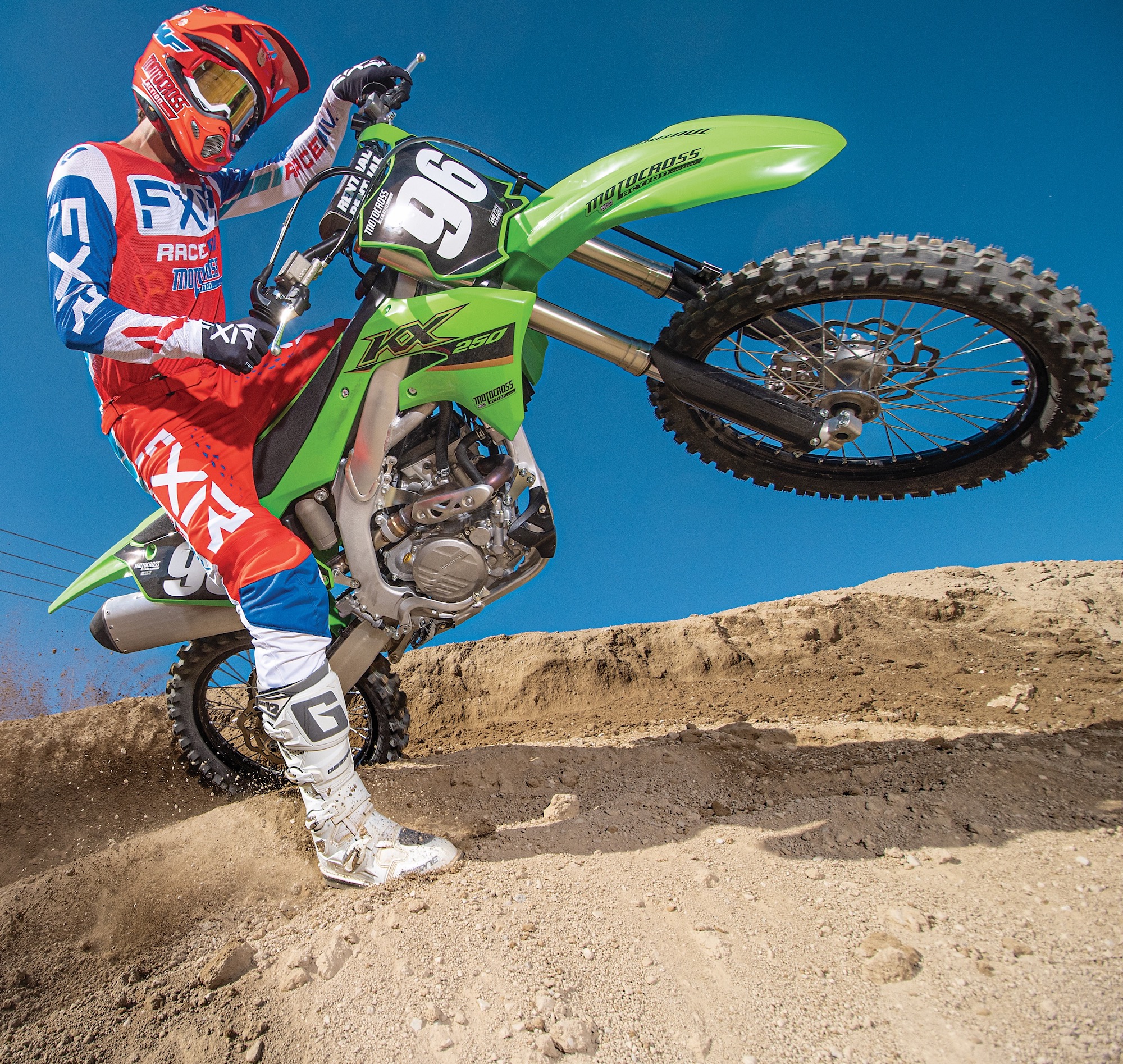 THE GEAR: Jersey: FXR Racing Clutch Pro, Pants: FXR Racing Clutch Pro, Helmet: Arai VX-Pro4, Goggles: FMF Vision Powerbomb, Boots: Gaerne SG12.
THE GEAR: Jersey: FXR Racing Clutch Pro, Pants: FXR Racing Clutch Pro, Helmet: Arai VX-Pro4, Goggles: FMF Vision Powerbomb, Boots: Gaerne SG12.
Q: FIRST AND FOREMOST, IS THE 2022 KAWASAKI KX250 BETTER THAN THE 2021 KX250?
A: Not by any stretch of the imagination. For 2022, the Kawasaki KX250 offers BNG and nothing more. If there were a year to do nothing, this was it. Why? Because out of the seven major brands, only the 2022 Honda CRF250 got a facelift this year, and that includes all the 450 four-stroke bikes as well. The pandemic pushed back updates and new models. There were some minor changes on the YZ250F and FC250, but nothing to write home about, meaning that the only bike that can move in the pecking order for 2022 is the CRF250.
We are unsure what year the KX250 is in its traditional four-year production cycle—not just because of the pandemic, but due to the fact that Kawasaki rolled out this generation KX250 in stages. In 2020, Kawasaki introduced its all-new top-end powerplant that offered the most peak power in its class but was tied for the lowest power numbers from 6000 to 8000 rpm. Then, in 2021, the new engine went into the updated KX450 chassis with the addition of an electric starter, hydraulic clutch and engine updates to add more desperately needed low-to-mid power. So, did this production cycle start in 2020 or 2021? We are hoping it started earlier rather than later, so a refined version of this model can be expected to hit the market in 2024.
Q: WHAT HAS BEEN UPDATED ON THIS GENERATION KX250 SINCE ITS INCEPTION?
A: Going further back in time, we reminisce about the 2012 through 2016 KX250F engine. It offered the best overall powerplant for each of those five years. It won MXA’s “250 Four-Stroke Shootout” from 2012 to 2014, then fell off the top of the charts due to its old-school handling. The generation that was released in 2016 offered better handling, lighter weight, improved ergonomics and better suspension, but the KTM, Husqvarna and Yamaha 250 four-strokes were hard to beat. Since then, Kawasaki has been in catch-up mode.
By 2019, the KX250F was in fifth place in MXA’s 250 Shootout, only beating out the elderly Suzuki RM-Z250. Kawasaki knew that it had to make big changes and did just that in 2020. The Kawasaki engineers threw the low-to-mid KX250 powerplant out the window and adopted an all-new high-revving powerband. They replaced the previous KX250 engine designer with someone who had recent success with high-reving road race engines, Seiji Azuma. Seiji was the chief engineer on the successful 2019 ZX-10R Superbike. His strength was not in motocross engines but in high-revving engines. Seiji adopted many of the things that KTM had already been doing for years.
He used the bigger 78.0mm bore (up from 77.0mm) and shorter 52.2mm stroke (down from 53.6mm), both borrowed from the KTM 250SXF. He ditched the bucket-and-shim system for the finger-follower valve actuation that KTM had been using since 2005. It was a logical move to incorporate finger-followers since their minuscule rocker arms allowed for more valve lift. More lift requires an aggressive cam profile that is difficult to achieve with a bucket-and-shim system. Combining the larger intake and exhaust valves with a higher compression ratio rewarded Seiji with the most powerful 250 four-stroke in 2020. Conversely, the engine was as much as 4 horsepower down from the top runners from 6000 to 9000 rpm.
In 2021, Kawasaki adopted the KX450 chassis and added the must-haves of 2022—electric starting and a hydraulic clutch. Learning valuable lessons from its high-rpm escapades with the 2020 engine, Kawasaki knew that the engine needed more low-end to mid-range power to help the KX250 get out of corners quicker. In response, Kawasaki made big changes to the 2021 engine by updating the crank, lengthening the connecting rod by 3mm, and stiffening up the valve springs. These changes closed up the low-to-mid power gap from 4 to 2 horsepower.
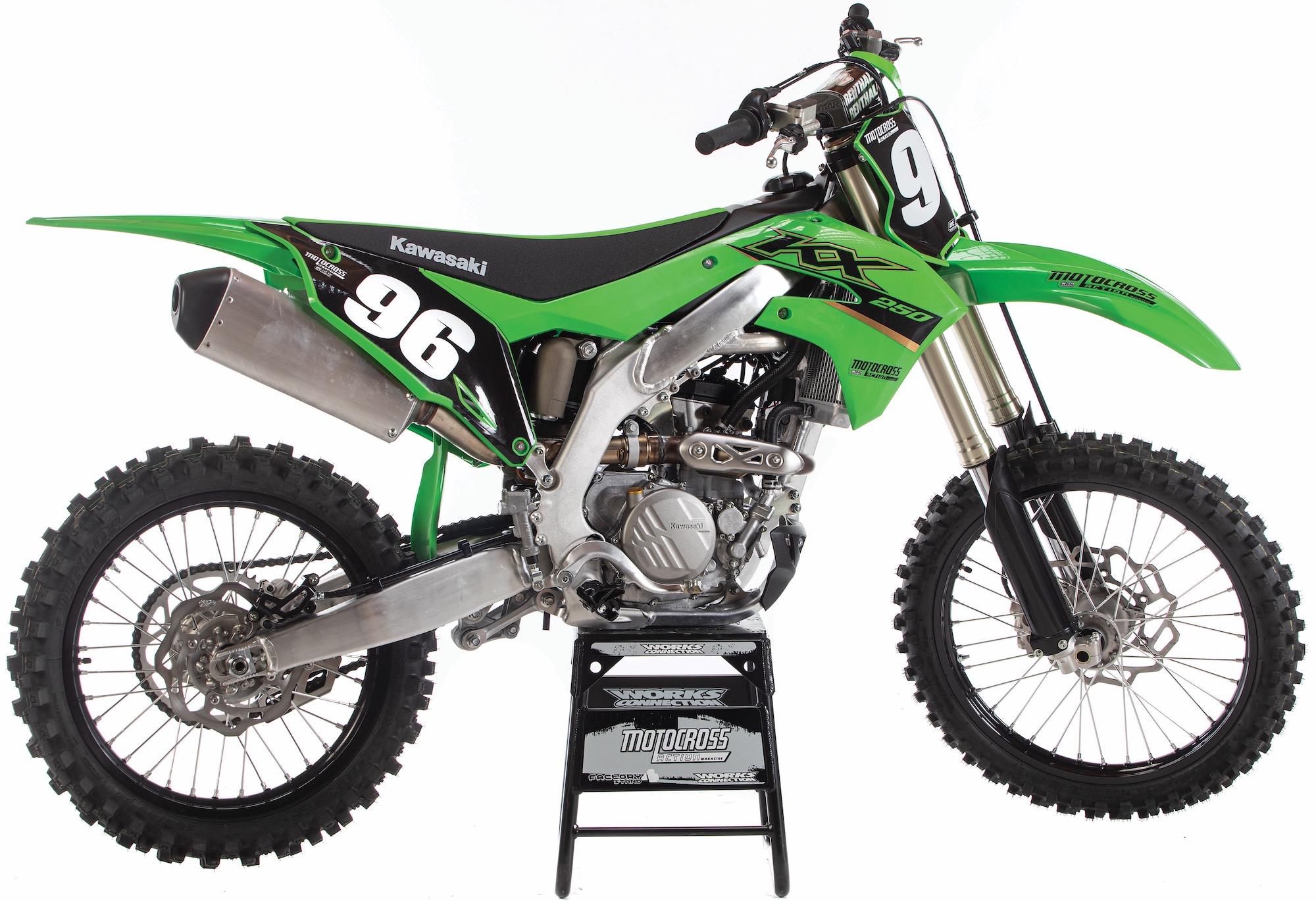 The 2022 KX250 is an identical bike to the 2021 model, save for BNG and a $100 raise in price.
The 2022 KX250 is an identical bike to the 2021 model, save for BNG and a $100 raise in price.
Q: HOW FAST IS THE 2022 KX250 POWERPLANT?
A: It feels faster on the track than it shows on the dyno. What do we mean? On the dyno, it looks like a slug from low to mid as it trails the top runner by more than two ponies from the crack of the throttle to over 9000 rpm. When the Husqvarna FC250 and KTM 250SXF take a breather at 9500 rpm, the KX250 leaps into the horsepower lead and stays there until 13,700 rpm, where the FC250 ekes out the KX250 by a mere 0.12 ponies at peak.
The KX250 is a pure high-rpm race bike. It needs to be revved to the moon to get the most out of it. You could say that this also applies to the KTM 250SXF, FC250 and GasGas MC 250F as well; however, the Austrian engines offer enough low-end grunt that they can hold their own should they need to be short-shifted.
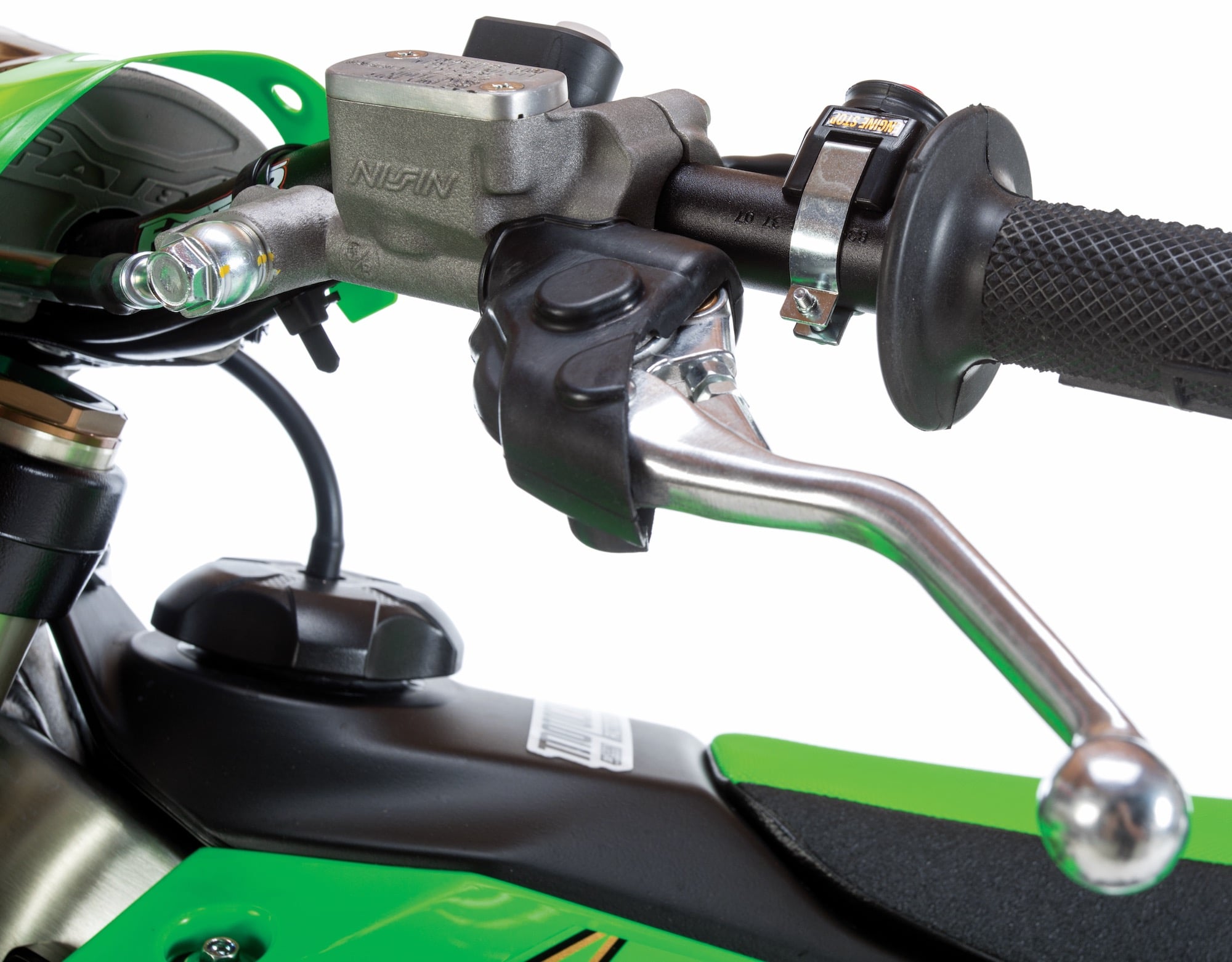 The Kawasaki KX250 hydraulic clutch was obviously borrowed from the KTM, but the hydraulic fittings on the master cylinder look like they were borrowed from Peterbuilt.
The Kawasaki KX250 hydraulic clutch was obviously borrowed from the KTM, but the hydraulic fittings on the master cylinder look like they were borrowed from Peterbuilt.
Getting used to revving the 2022 KX250 was one thing, but the constant shifting to stay up there was another cross to bear. In order to keep the KX250 in the meat of its high-revving powerband, test riders preferred to downshift an extra gear in corners to get more drive, which meant they had to shift up a couple gears to get back in the high-rpm pocket. Amazingly, there were times when our fastest Pro test riders had to go down to first gear in tight, rutted corners to get the most acceleration out of the green machine.
Once the testers found their footing on the KX250, they all felt that it could go head-to-head with the top runners in the 250 class. It was just harder to do than on the YZ250F, KTM 250SXF, Husky FC250 or GasGas MC 250F. On the KX250, you have to be very precise with your shift points and avoid mistakes if you want to maximize performance. We said this last year and we will say it again, “If you have 125cc two-stroke experience, you’re off to a great start on the KX250.”
Q: DID THE PRICE CHANGE, EVEN THOUGH THE 2022 KX250 IS IDENTICAL TO LAST YEAR?
A: In the past three years the price has jumped $650 on the KX250. It now stands at $8399. The biggest price jump was in 2021 with the addition of the hydraulic clutch and electric start; it accounted for $500 of the $650 price hike. For 2022, the price increase was another 100 bucks for BNG. Don’t think that Kawasaki was the only manufacturer to up its prices for 2022. Every other manufacturer raised its price by at least $200 for 2022 (save for the Suzuki RM-Z250 which stayed at $7899).
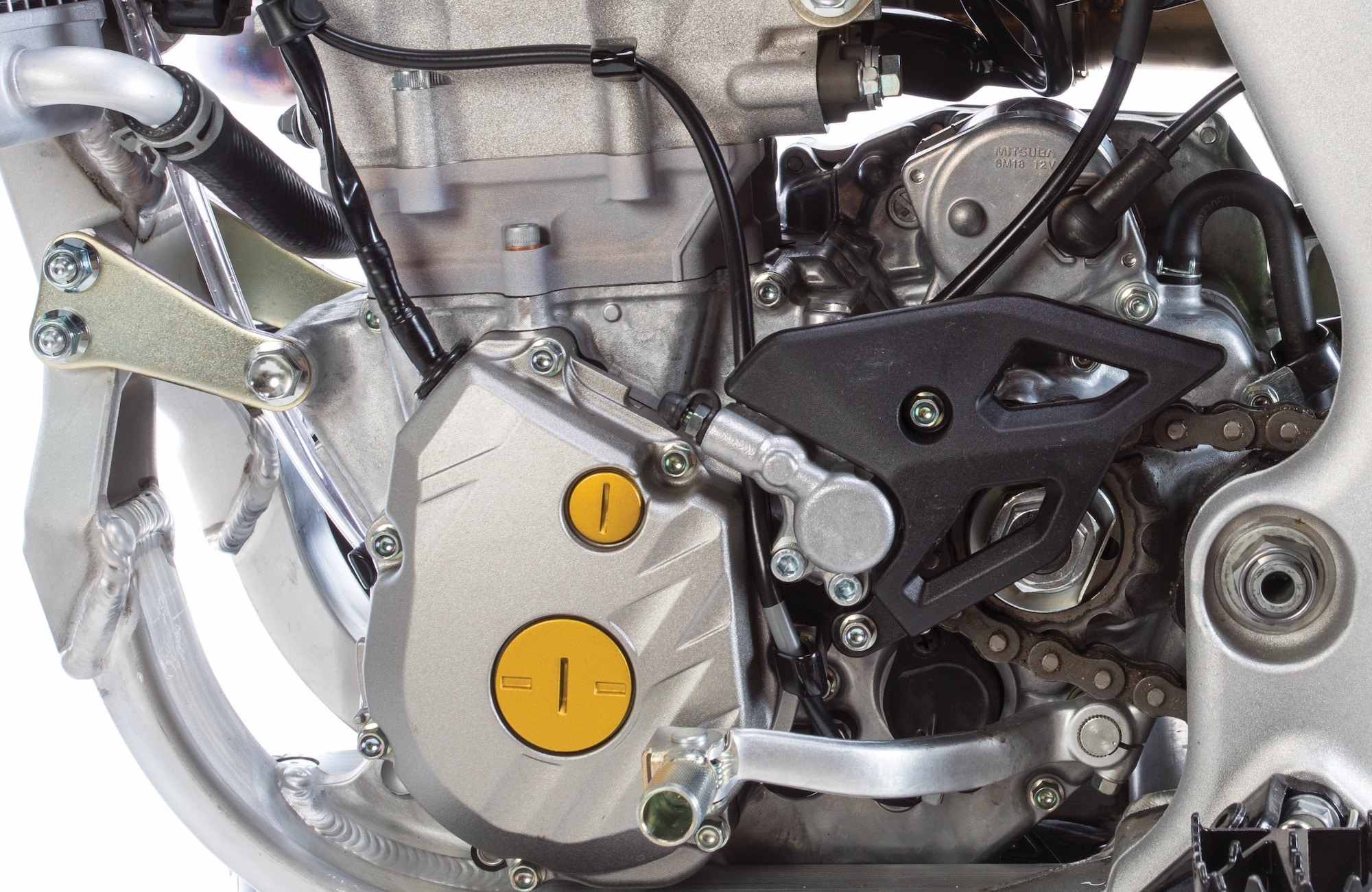 Note the amount of space between the front of the engine cases and front down tubes. The KX250 engine is tucked way back in the KX450 frame so that the swingarm pivot can go through the cases.
Note the amount of space between the front of the engine cases and front down tubes. The KX250 engine is tucked way back in the KX450 frame so that the swingarm pivot can go through the cases.
Q: HOW DOES THE KX250 HANDLE?
A: First, the good news. The straight-line stability is great. It tracks straight as an arrow. Second, the bad news. The straight-line stability is not enhanced by the KX250s lack of turning precision. It doesn’t want to turn. You could do the bomb run at a National Hare & Hound in fifth gear wide open without a hint of head-shake, but you can’t carve into a corner without the front end pushing. This is not optimum handling on a motocross track. In stock trim, the front end is high. The feeling brought us back to the old-school handling traits of the 2012 through 2016 chassis. Back then, the awesome KX250 engine could overshadow the poor handling. Not anymore! We tried pushing the forks up in the clamps and raising the sag to put more weight on the front. These changes had adverse effects. Maybe it’s just us, but we blame the poor handling traits on the smaller KX250 engine being mounted too far back in the larger KX450 chassis. The 2022 KX450 engine is heavier and farther forward than the KX250, which allows it to weight the front wheel. The KX450 doesn’t understeer, but the KX250 does.
If the track is soft or rutty, the KX250’s light front-end issues are easier to tolerate. If you get forward on the bike, sitting on the gas tank coming into corners, the bike will turn in fairly easily. If you don’t slide forward, the KX250 will stand up at the apex. Once you find the perfect strategy (and place to sit), the KX250 slices its way through turns like a hot butter knife. Ruts, berms and things to press the front wheel against are the KX250’s best friends. On corner exit, it feels like the rear of the bike is doing most of the work.
In case you missed our point, we don’t care much for the KX450 chassis with the KX250 engine. It is safe to say we liked the 2020 chassis better. Give us the 2020 chassis with the 2022 engine and we will be happy riders. The KX250 has things that it does well, but building confidence in corners is not one of them.
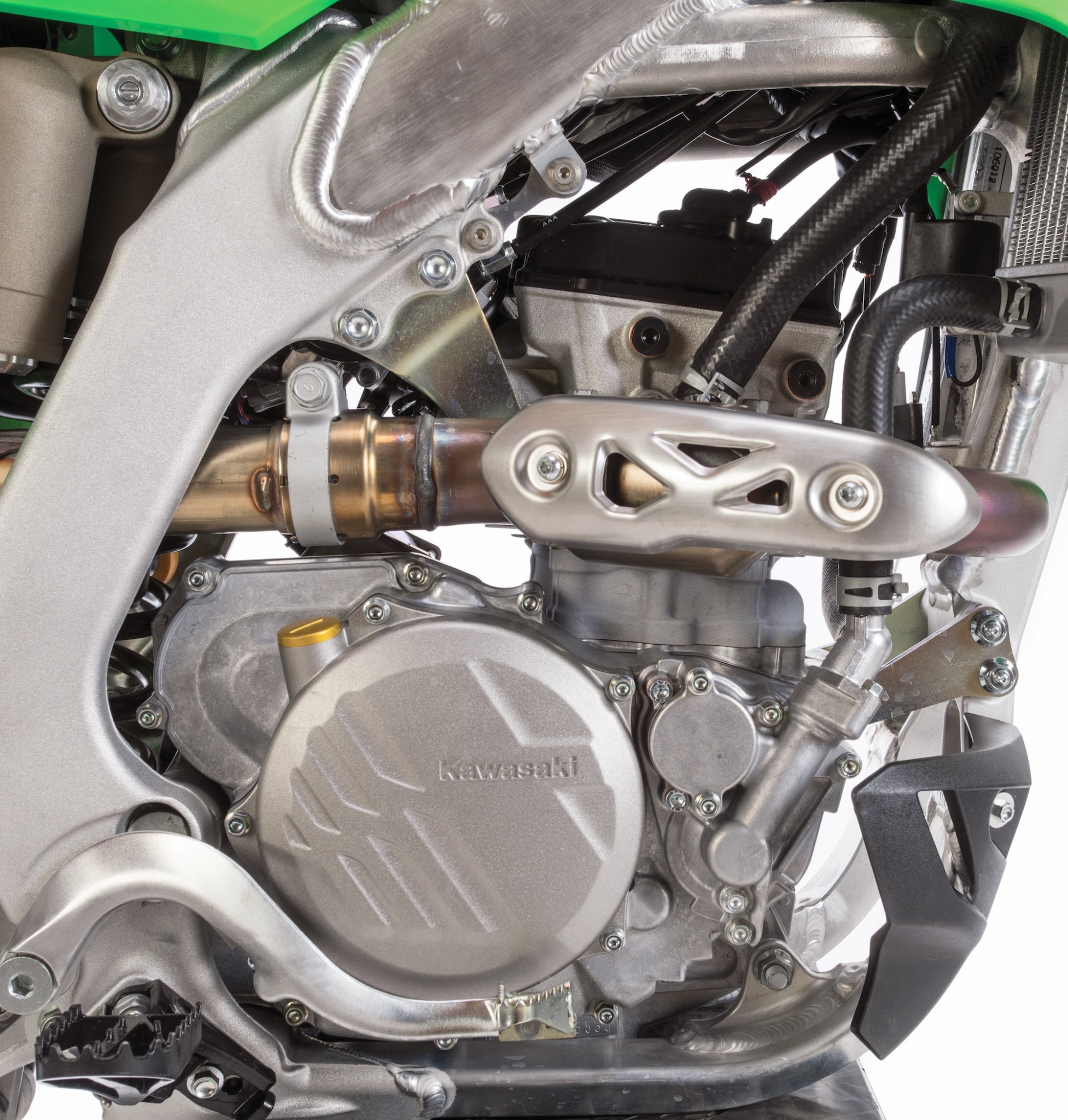 This engine is impressive. When it hits the afterburners, hang on!
This engine is impressive. When it hits the afterburners, hang on!
Q: WHAT DO WE THINK ABOUT THE KAYABA SUSPENSION COMPONENTS?
A: This chassis doesn’t make it easy for a suspension tuner to find proper fore and aft balance. The shock feels great the first time you ride the bike, but the forks feel like they need work. After you try to fix the forks, the shock suddenly becomes the problem. It is a vicious cycle of bad settings. The suspension settings are tailored for 103mm of sag. We went down to our normal 105mm, but we lost more than we gained at the front end. The rear handles better at 105mm, but the overall chassis balance was thrown off.
Since the forks are where the complaints started, we will start on a positive note by saying that the first part of the stroke is supple and the last part of the stroke ramps up enough to take really big hits. The problem lies in the mid-stroke. The valving ramps up too fast too soon in the middle to the bottom part of the stroke. If we went out on the compression clickers, then the forks dropped into the harsh part of the stroke, which made test riders claim that the forks were too stiff. When we went stiffer on the compression to get the KX250 forks to ride higher in their stroke, we couldn’t use enough travel to get the most out of the forks. We were at an impasse.
If you want to get the best out of these forks, send them to your favorite suspension tuner. We are biased towards Pro Circuit, as they know more about Kawasaki forks than anyone in the business.
Q: HOW WAS THE MAPPING OF THE THREE COUPLERS?
A: Each of the three maps offered on the KX250 served a purpose. They were all distinctly different from each other. Kawasaki gives you three interchangeable couplers. The green coupler is stock, the white coupler is aggressive, and the black is mellow (although we wouldn’t call any of the couplers mellow). Why not? The black coupler offers the most aggressive low-end power, but it signs off earlier than the other two. With the black coupler, test riders could hit corners in second gear where they had been using first gear with the green and white couplers. The white coupler was the most aggressive from mid to top, although the engine braking was excessive. We didn’t like the feeling at all. The stock green coupler was middle of the road.
We wanted the best of the aggressive white coupler, without the heavy engine braking, matched to the perky low end of the black coupler. Kawasaki’s top tuner, Mike Chavez, brewed us up some concoctions with the Kawasaki FI calibration kit ($699.95). After a few different maps, he combined the Ignition map of the aggressive map with the Fuel map of the mild map. They went together like white on rice. This custom map gave the KX250 more snap off the bottom without sacrificing anything on top.
Q: DID WE CHANGE THE STOCK GEARING?
A: Yes. With the stock gearing we were spending too much time in first gear. Not that being in first gear is a bad thing, but the overall gear ratios were too low, which moved the shift point to the center of the corners instead of the more advantageous exit to the turn. It was tough to find the optimum shift points. Plus, with the KX250 revving to 14,500 rpm, we could not afford to bring some of the power down without risking complaints.
We went up 1 tooth in the rear to a 52. This lessened the need to go to first gear by bringing second gear into play sooner. It didn’t cut down on the KX250’s obsessive need to be shifted constantly, but it helped tremendously in boosting gear-to-gear thrust.
 If the forks worked as good as the KX250’s shock we would love this bike.
If the forks worked as good as the KX250’s shock we would love this bike.
Q: WHAT DID WE HATE?
A: The hate list.
(1) Seat bolts. Every time you remove the seat, the backing plate for the seat bolt falls on the ground. We tried silicone, Super Glue and contact cement, but, annoyingly, nothing worked until we found Bolt Motorcycle Hardware’s KX250 T-plates.
(2) Chain roller. The front chain roller starts to wear down after five hours. At 10 it will start to come apart. Order a TM Designworks chain roller. And while you are at it, order a chain guide as well, because at 15 hours you will need one.
(3) Decibels. This is a very loud bike. The only places it will pass sound regulations are places that don’t have any regulations.
(4) Forks. These forks ramp up too fast, creating a harsh spot you can’t run away from unless you get them re-valved.
(5) Chassis. The front-end geometry makes the front end want to push. We tried putting more weight on the front by raising the forks in the clamps, but that brought up other issues.
Q: WHAT DID WE LIKE?
A: The like list.
(1) Ergonomics. The narrow chassis makes you feel at home on the bike. If you don’t like the feel, try moving the adjustable footpegs and bar mounts.
(2) Maps. We like that each of the three maps is distinctly different, and all three work in their chosen field of expertise.
(3) Shock. The Kayaba shock is good; we just wish the forks worked as well.
(4) Engine. This engine thrives in a high-rpm environment. Hardcore racers will love this engine.
(5) Brakes. The brakes are a plus.
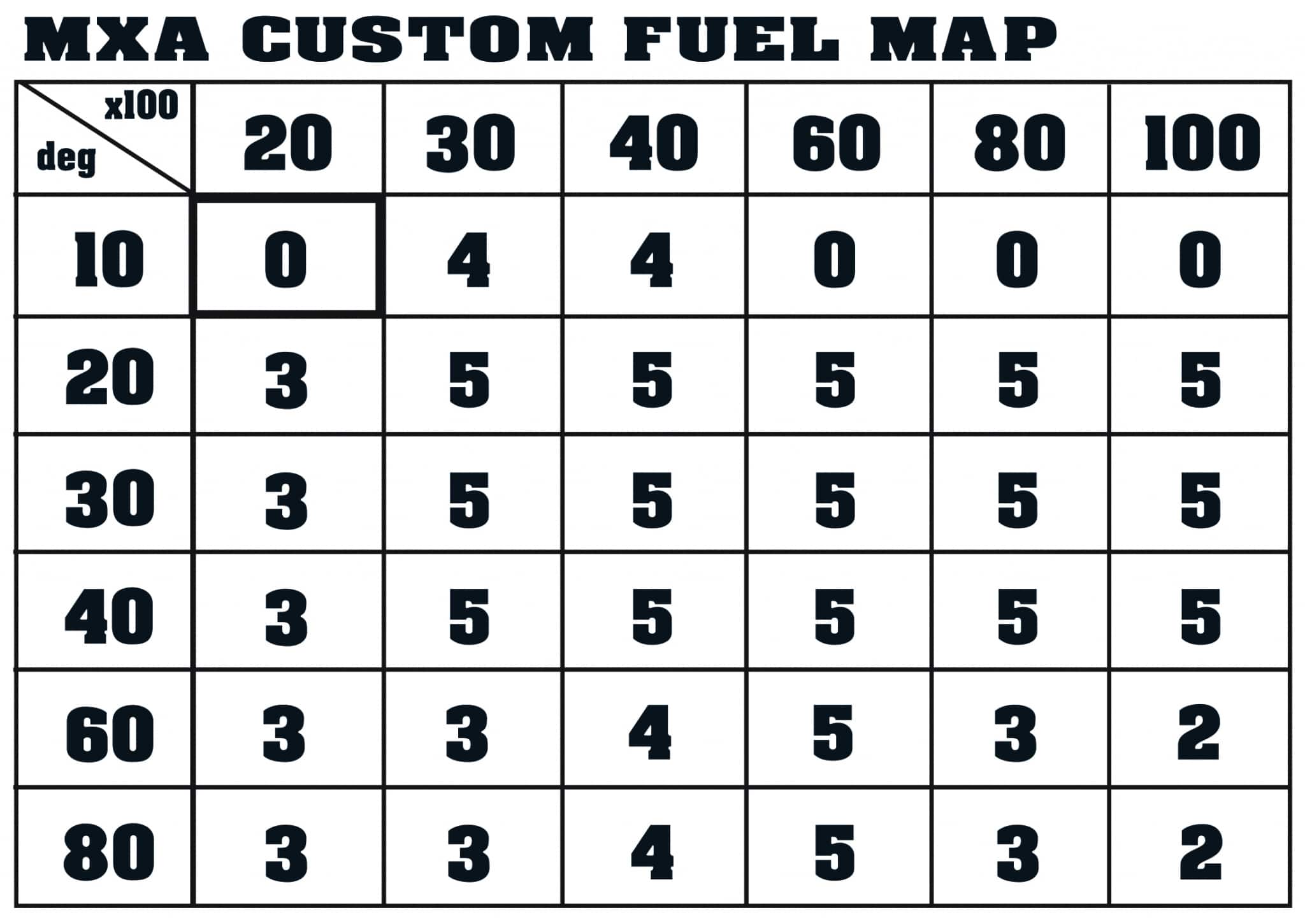 These are the fuel settings from the stock mellow map that we combined with the ignition settings (below) from the aggressive map.
These are the fuel settings from the stock mellow map that we combined with the ignition settings (below) from the aggressive map.
Q: WHAT DO WE REALLY THINK?
A: The KX250 is a fun bike to ride. It revs to the moon, and you can feel the potent power on the track. We just don’t think this engine is simpatico with the jumbo-sized KX450 chassis. Once Kawasaki figures out how to balance out the chassis, the KX250 will be a real threat in the pack of 250cc wolves. A good suspension tuner can get your KX250 handling headed in the right direction.
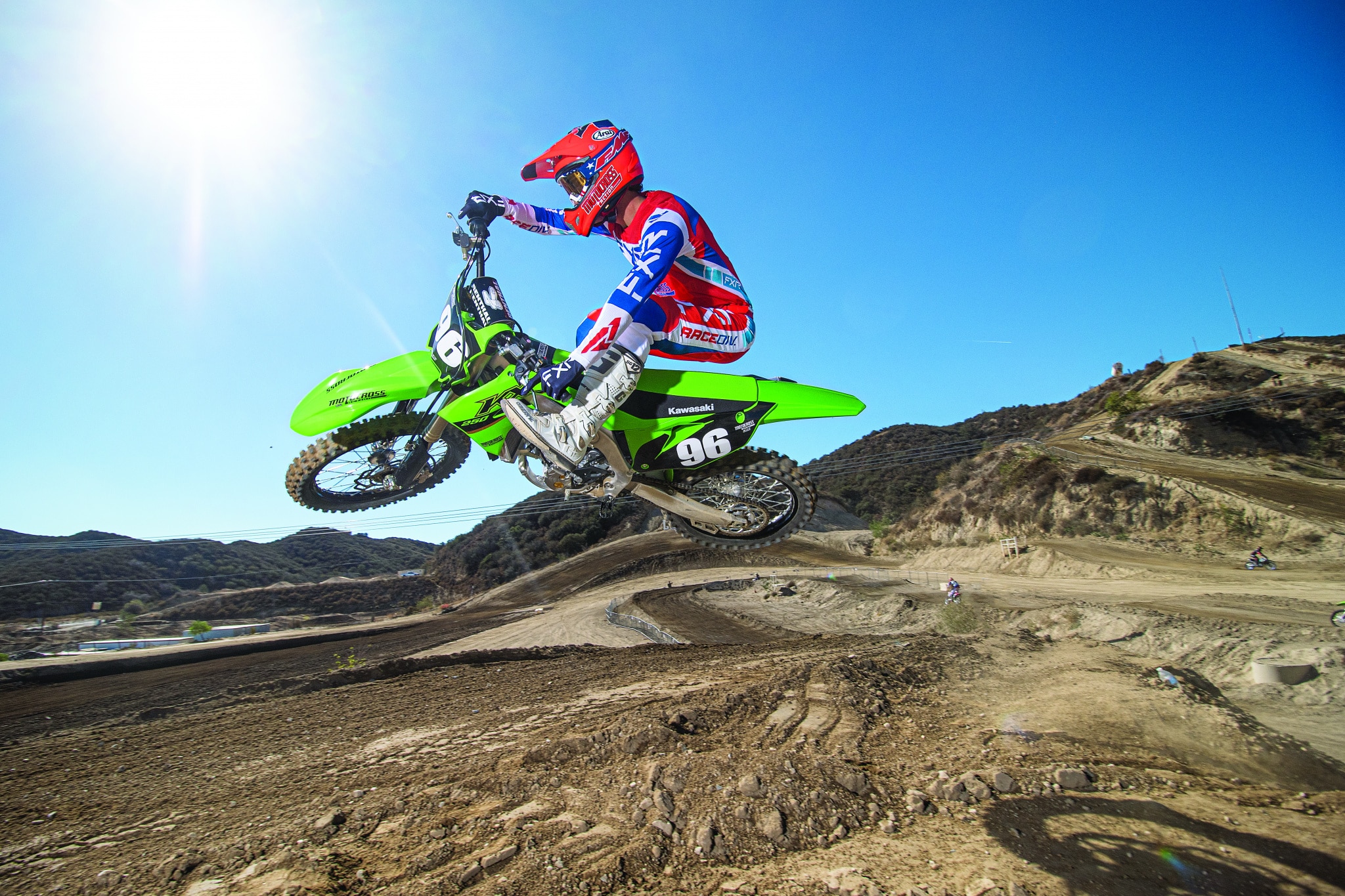 The KX250 is one of the slimmest bikes in its class. You have the feeling you can flick it around no problem.
The KX250 is one of the slimmest bikes in its class. You have the feeling you can flick it around no problem.
MXA’S 2022 KAWASAKI KX250 SETUP SPECS
KAYABA 48MM FORK SETTINGS
The 2022 KX250’s Kayaba forks, in the older chassis, worked much like the SSS forks on the YZ250F. Not anymore! The forks ramp up too fast. The KX250 forks are supple at the top of the stroke (great for smooth tracks), but when the KX250 hits rougher terrain, the problems start. There is no way around the harshness without breaking into the internals. For hardcore racing, we recommend this fork setup for the 2022 Kawasaki KX250 (stock specs are in parentheses):
Spring rate: 4.9 N/mm
Compression: 8 clicks out (12 clicks out)
Rebound: 12 clicks out (11 clicks out)
Fork-leg height: Standard
Notes: On rough tracks, the softer you go, the further the forks will compress and hit the harsh part of the stroke. We went a few clicks stiffer to ride above the harshness.
KAYABA SHOCK SETTINGS
Testers felt comfortable with this shock. We went back and forth from 105mm of sag to 103mm. Testers found a better overall setting at 103mm, which is Kawasaki’s standard setting. We went in two clicks to slow the rebound down. For hardcore racing, we recommend this shock setup for the 2022 Kawasaki KX250 (stock specs are in parentheses):
Spring rate: 54 N/mm
Race sag: 103 mm
Hi-compression: 1.5 turns out
Lo-compression: 10 clicks out
Rebound: 13 clicks out (15 clicks out)


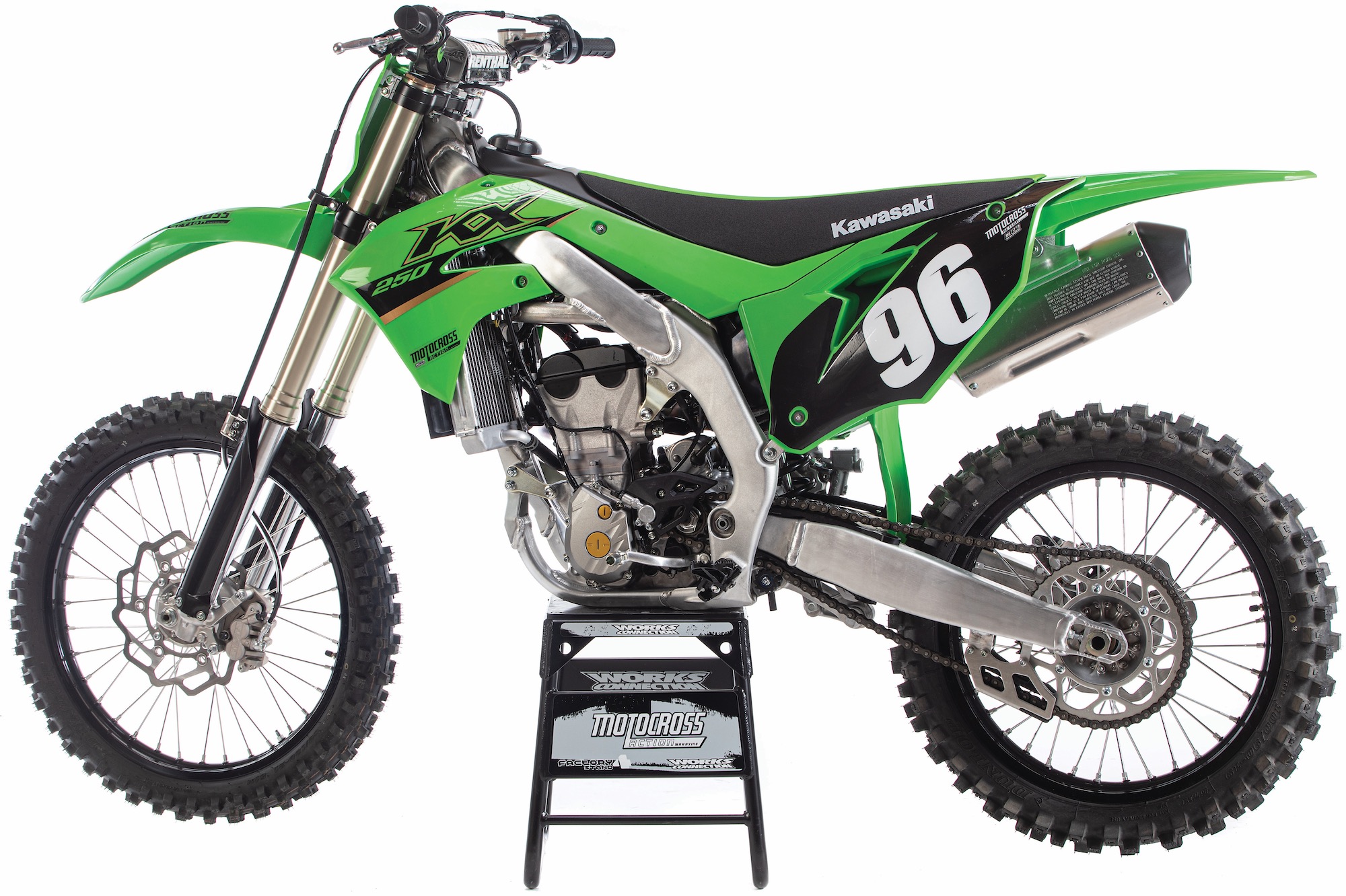
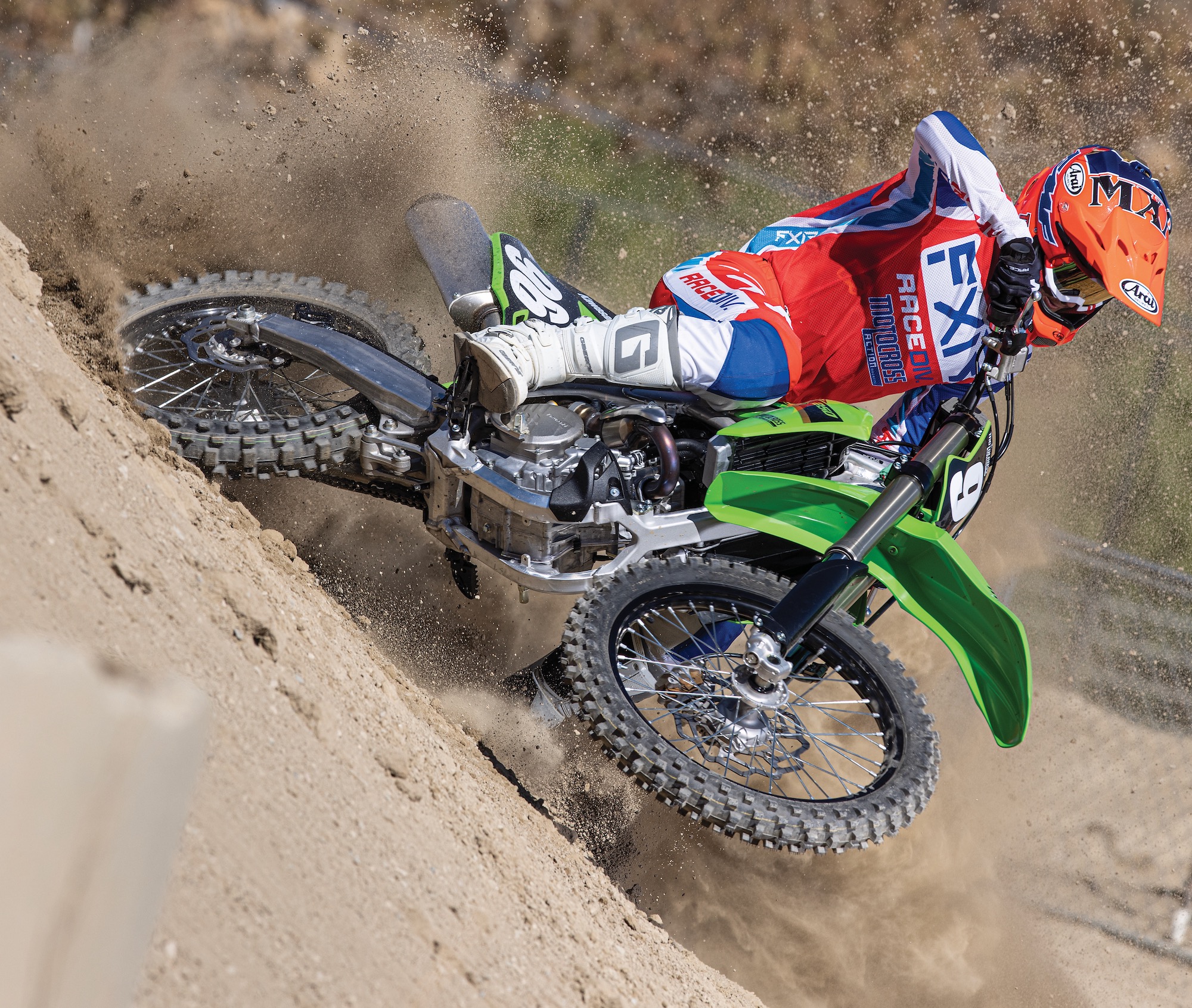

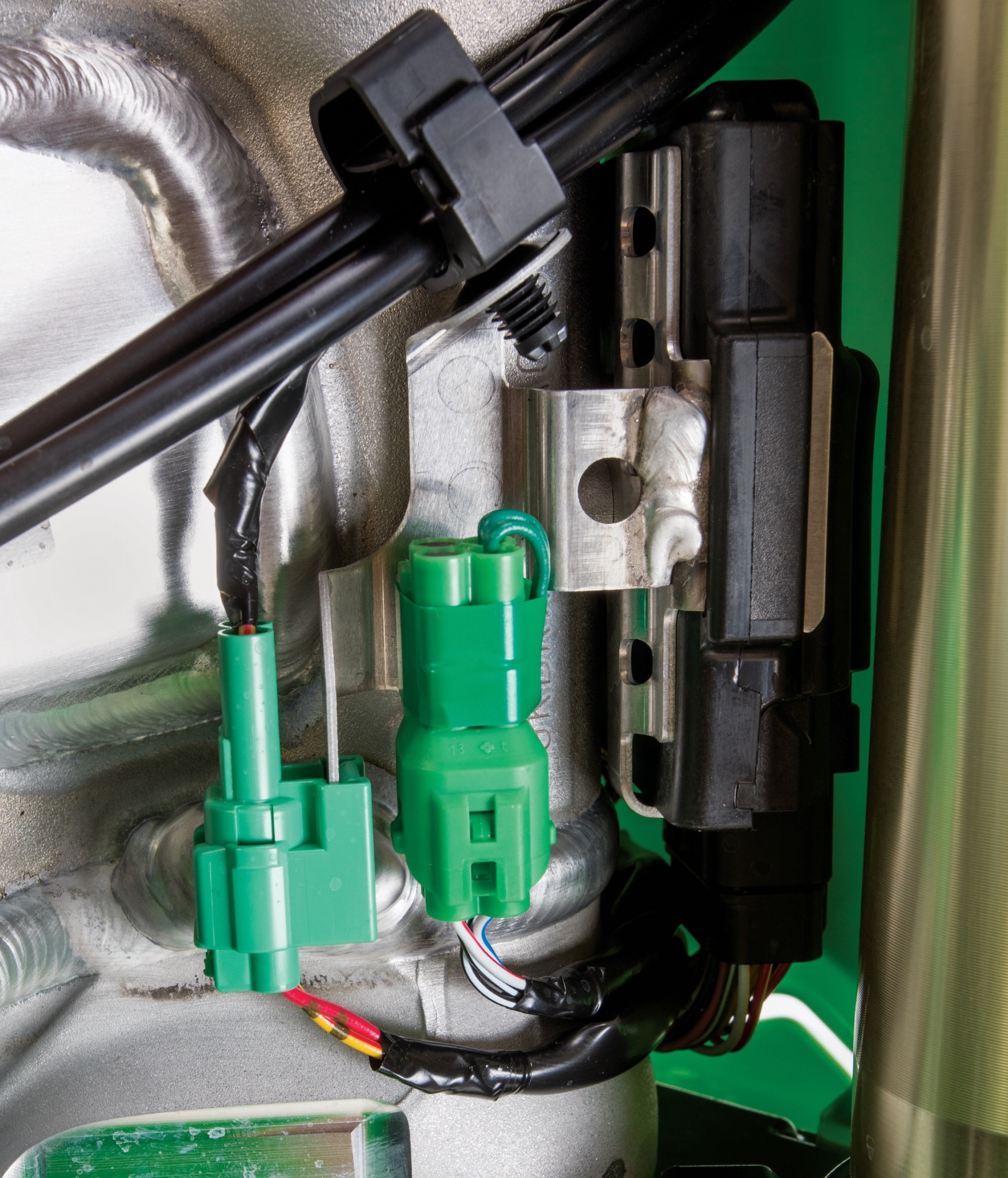
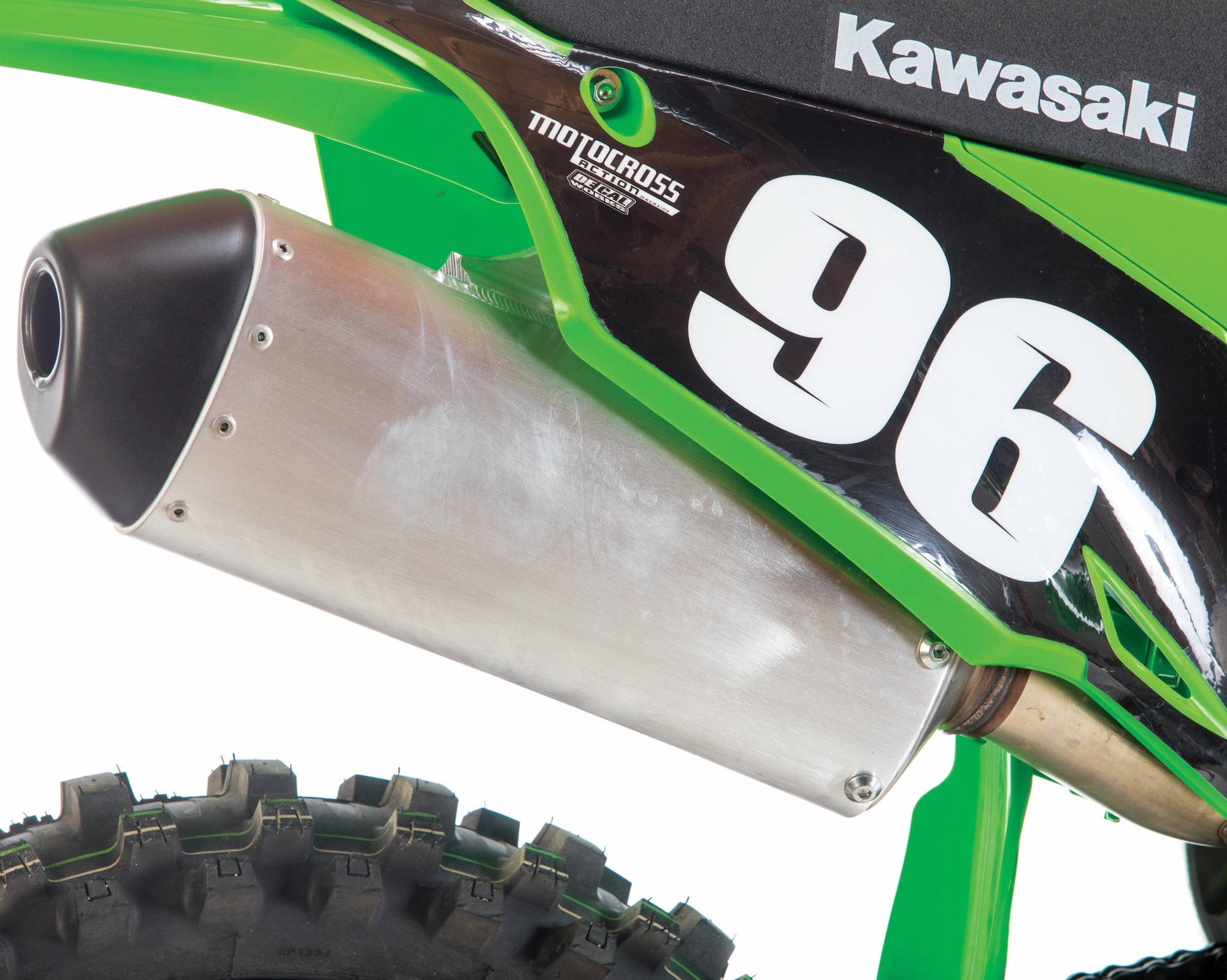




Comments are closed.